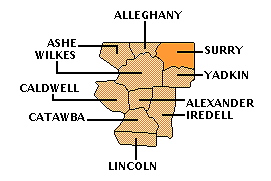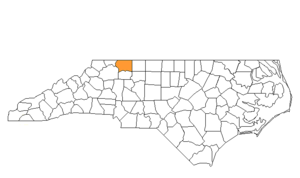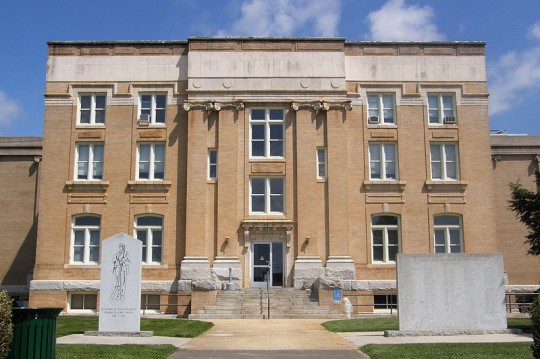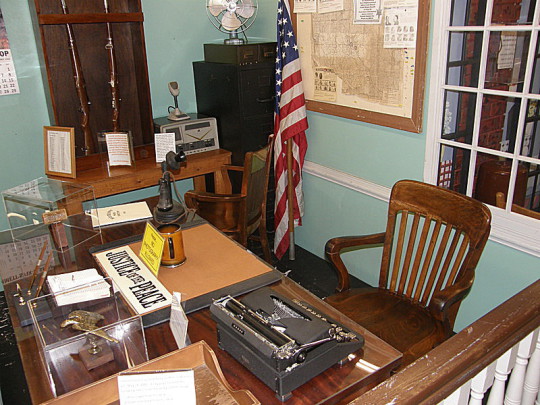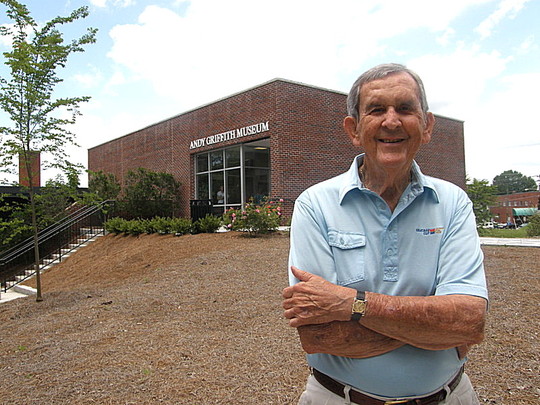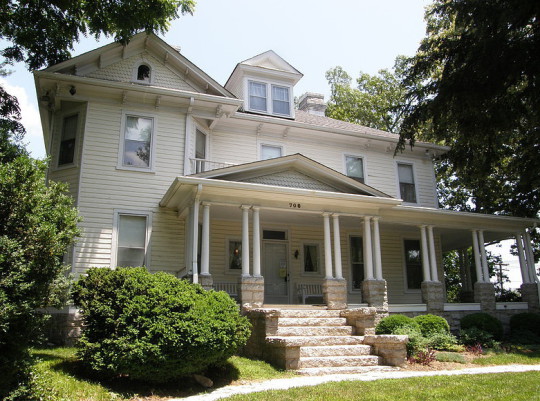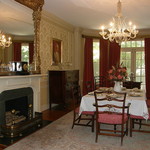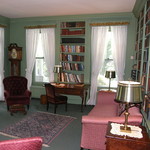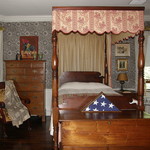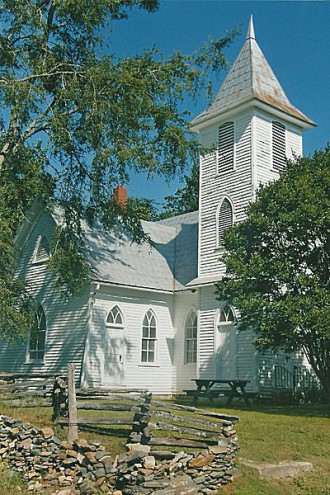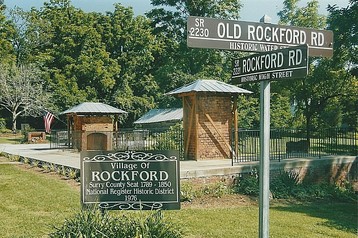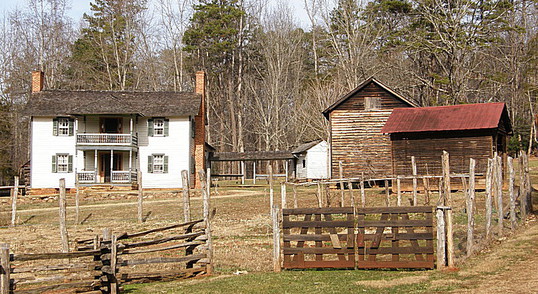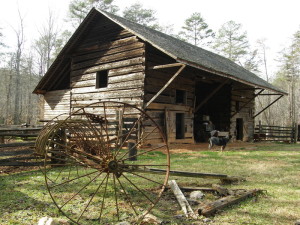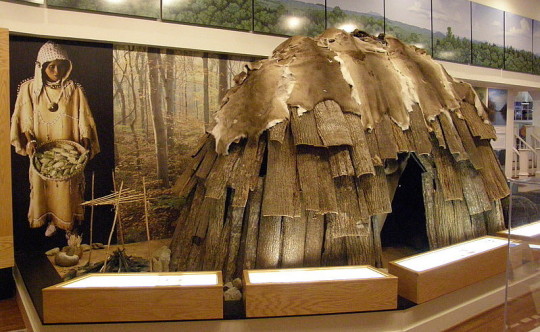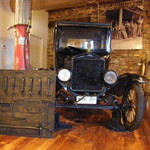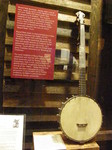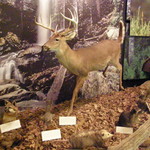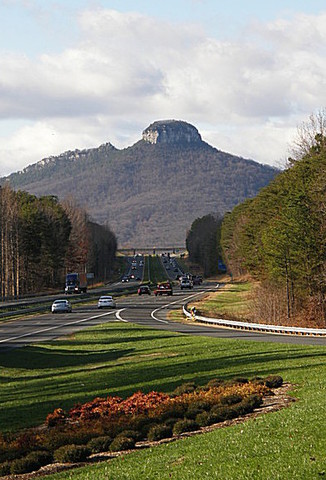SURRY COUNTY
Scroll down this page or click on specific site name to view features on the following Surry County attractions/points of interest:
Andy Griffith Museum, Historic Rockford, Horne Creek Living Historical Farm, Mount Airy Museum of Regional History, Pilot Mountain State Park
Fast facts about Surry County:
Created in 1771, the county is named either for the county of Surrey in England, birthplace of Royal Governor William Tryon, or for the Saura Indian tribe, early inhabitants of the area.
The county seat is Dobson, named either for local resident William Dobson, or for William P. Dobson, a member of the General Assembly. Other communities include Elkin, Mount Airy, Pilot Mountain, and Toast.
Surry County’s land area is 536.52 square miles; the population in the 2010 census was 73,673.
It is worth noting that Mount Airy was the childhood home of Andy Griffith and was the inspiration for the town of Mayberry on “The Andy Griffith Show.”
Below: Surry County Courthouse, Dobson
Mount Airy
Since its opening in September, 2009, the Andy Griffith Museum in Mount Airy, showcasing all manner of memorabilia from the actor’s long career on stage, screen, and tele-vision, has been drawing hundreds of visitors each week. Programs, posters, photographs, and props are plentiful. All are part of the private collection of Emmett Forrest, a childhood classmate and life-long friend the town’s most famous native son. Pieces of Forrest’s extensive collection had been displayed at various sites over the years, but it wasn’t until 2009 that a building specifically designed to be the home of the Andy Griffith Museum was completed. From the outside, the structure is small and unassuming, but inside, the museum brims with the kinds of collectibles that fans love to see – original movie posters and lobby cards, signed photographs, and, in the case of the beloved “Andy Griffith Show” itself, some of the most fondly-remembered props from the series, including the keys to the Mayberry jail, Sheriff Taylor’s desk, the office chair used by Don Knotts (bronzed, and autographed by 72 members of the show’s cast and crew), and the signs “Sheriff” and “Justice of the Peace” which hung on the Mayberry courthouse doors. Otis’ ragamuffin coat, hat, and tie are displayed, along with one of Sheriff Taylor’s shirts, proudly bearing the logo of its maker, Hollywood’s legendary Nudie’s Rodeo Tailors. Yet another artifact is sheet music for the show’s catchy theme song, signed by composer Earle Hagen. Not everything in the museum relates to Andy Griffith – there’s memorabilia from the careers of several other cast members, in particular the late Don Knotts (unforgettable as “Deputy Barney Fife”) and Betty Lynn (“Thelma Lou”), who now makes her home in Mount Airy and makes frequent appearances at the Museum.
There are “Matlock” mementos on display as well, and items from many of Griffith’s feature films, but some of the most interesting exhibits have to do with Andy’s early life and fledgling career. Among these is the hand-crafted rocking chair Carl Griffith made for his wife, Geneva, in which to rock their newborn son, Andy. Others are programs from the outdoor drama “The Lost Colony.” It was while Griffith was honing his stage skills at Manteo’s Waterside Theatre that he met his first wife, fellow cast member Barbara Edwards, who played the role of Eleanor Dare. Andy played Sir Walter Raleigh. Then there is the weathered souvenir from a UNC football game Andy attended in the early 1930s, the memories of which inspired his recording “What It Was, Was Football,” the rollicking comic classic still heard occasionally over the airwaves today, usually during the college football season.
Among the items that had the most meaning for Forrest, whom Andy affectionately referred to as “keeper of the flame,” are candid photographs taken of Andy during a rare visit to his childhood home in 2004. In the company of wife Cindi, friend Emmett, and Surry Arts Council Executive Director Tanya Jones, Andy was able to return to his home town and spend some quiet time away from the crowds revisiting a few of the important places from his childhood. Not the least of these was the old Rockford Street Grammar School auditorium – now the Andy Griffith Playhouse – where, as a third-grader, Andy made his stage debut, performing a solo version of “Put on Your Old Gray Bonnet” at the year-end student assembly program. Many years older, but no less inclined to please his audience, Andy once again took the stage, clasped his hands behind his back, and, rocking gently side to side, reprised the song to the delight of his listeners. The Andy Griffith Playhouse and Andy Griffith Museum are on Rockford Street, one block off Main. The Museum is open daily except holidays. Hours are 9-5 Monday-Friday, 11-4 Saturday, and 1:30-4:30 Sunday. Admission charged. 336-786-7998
"Keeper of the Flame" Emmett Forrest stands in front of the Andy Griffith Museum in Mount Airy.
Mount Airy
The Gertrude Smith House is a Mount Airy treasure, a handsome property listed on the National Register of Historic Places. The house was built in 1903 by Miss Smith’s father, successful merchant Jefferson Davis Smith. He married Mount Airy native Gertrude Gilmer, and the couple had seven children – five sons and two daughters. Four of the children married and moved away, but three siblings – Gertrude, Cameron, and Robert – remained single and lived their lives in this home. Gertrude Smith was an interior designer by training, and her Victorian-style house naturally reflects many of her trademark touches – tall mirrors filling wall space between windows or archways, corner cabinets, and stamped brass cornice boards. All furnishings seen in the house are Smith family heirlooms, pieces collected by Miss Smith on her antiquing trips to the mountains, or items brought back by Dr. Robert Smith as he traveled around the world while in the military. Gertrude Smith died in 1981 at age 90, willing that the house be opened to the public as a “living” museum and providing the necessary funds to maintain it as such. Today the house appears as though still occupied by the Smiths, with nothing changed in its appearance in nearly a quarter-century. Hours are 11-4 Monday, Wednesday, Friday, and Saturday. Admission is free. 336-786-6856
Rockford
The historic village of Rockford, established in 1789 as the county seat for Surry County, is undergoing a slow-but-steady revitalization. It’s a worthwhile stop for folks heading to or from Mount Airy or Pilot Mountain State Park. For those driving the Yadkin River Wine Trail, Rockford is within a short drive to several area wineries. The Rockford Preservation Society, formed in 1972, currently oversees six properties, including the former Methodist Church, built in 1914 and donated to the Society by the Methodist Conference in 1984. The restored church building serves as the community center, hosting meetings, socials, and such special events as the annual “Candlelight Christmas” program held the first Thursday and Friday in December. Gracing the front of the old sanctuary is a fresco entitled "Come Unto Me" by North Carolina native Tony Griffin, brother-in-law of renowned fresco artist Ben Long. Griffin's inspirational work, dedicated in 1989 in a ceremony commem-
orating Rockford’s bicentennial, depicts the life-sized figure of Jesus with arms outstretched, inviting those who are weary and burdened to find rest. Other properties restored by the Society are the Dudley Glass house, circa 1850, and the old post office, built around 1899. The former is now home to Rockford Mercantile, a combination Christmas shop and history store. Visitors will want to check out the back room, where exhibits shed light on Rockford’s history as, first, Surry’s county seat and, later, a busy stop along the Southern Railway. A detailed model of the former Grant-Burrus Hotel, done by a group of history students, is among the displays. Yadkin River Photography now occupies the post office building. Two historic buildings still undergoing the arduous and expensive process of restoration are the Mark York Tavern and the Masonic Lodge. The tavern, built in 1831, has recently been added as a stop along North Carolina’s Civil War Trail. A marker in front of the building details events which took place here during Stoneman’s Raid in the spring of 1865. Across the highway is Unanimity Lodge No. 34 of the Masonic Order, originally chartered in 1797. A new charter was granted in 1866 and the Lodge became Rockford Lodge No. 251. It is believed to be the oldest lodge in the northwestern section of the state. Attached to the building is Rockford’s last post office, which operated from 1914-1975.
In 1974, fire claimed Rockford’s most imposing building, the expansive Grant-Burrus Hotel. For many years, all that remained of the structure, a portion of which dated had back to 1796, were three brick chimneys. As these were in danger of collapsing, the Society removed bricks from the tops of the chimneys and lowered them to a safe height. The recycled bricks were then used to create the foundation for a patio area. The pleasantly-landscaped Rockford Park now occupies the site of the old hotel at the very heart of the National Historic District. Visitors often make use of the park’s picnic tables and benches after visiting the old-fashioned Rockford General Store across the street and treating themselves to favorite candies and soft drink flavors from their childhood. Serving customers since 1890, the rustic country store still embraces its role as a community gathering place. Just up the road, innkeepers Doug and Hannah Holyfield welcome guests to the Rockford Inn Bed & Breakfast, an 1848 farmhouse. The Inn offers cozy lodgings and home-cooked breakfast specialties in a relaxed setting. To get to Rockford, take Exit 82 off I-77 and drive east on NC 67. Three miles east of Boonville, turn left onto Rockford Road. The village of Rockford is about 2.5 miles ahead, just north of the Yadkin River. The Methodist Church is open daily. Rockford General Store is open 10-5 Wednesday-Saturday and 12-5 Sunday. Rockford Mercantile and Yadkin River Photography are open 11-5 Saturday and 1-5 Sunday. Call 336-374-6644 for information about the Rockford Inn.
West of Pinnacle
Horne Creek Living Historical Farm near Pilot Mountain State Park offers visitors a sampling of life on a North Carolina farm in the mid-19th century. The site is different from the other historic sites maintained and operated by the state of North Carolina in that it does not honor a specific individual or commemorate a singular historic event. Instead, it seeks to preserve and commemorate a lifestyle that, once common across the Carolina Piedmont, is now rarely found.
The property originally belonged to John and Elizabeth Hauser, who began tilling a portion of their 100 acre farmstead in 1830. They also built a log cabin home and began raising a family. Over time, the Hausers had five sons and two daughters. With the help of three slaves, the Hauser family made their Surry County farmstead prosperous. Fortunes reversed with the coming of the Civil War. Three sons joined the Confederacy, but only one returned. Elizabeth died in 1864. In the years following the war, youngest son Thomas inherited the farm and assumed responsibility for its operations. The sprawling farmhouse that stands today was begun in the mid-1870s by Thomas Hauser and was added onto many times in the years to follow as family additions necessitated. In all, four generations of the Hauser family – two of which bore twelve children each – lived and worked on the farm. In was not until the 1960s that farm operations were assumed by individuals outside the family.
The property came under state operation in 1987, making it the most recent addition to the state’s historic sites. A small staff maintains the property as a self-sufficient working farm circa 1900 to 1910, and visitors can expect to see a variety of activities being carried out at various times during the day. Apples orchards and cornfields are cultivated and harvested; cows, chickens, and sheep are tended. All manner of aromatic treats are regularly cooked in the kitchen attached to the rear of the house. A visit to the kitchen on a hot summer’s day will make visitors appreciate the extreme heat with which the Hauser womenfolk had to contend as a part of their daily routine.
The farmhouse has recently been given a “lived-in” look with the addition of appropriate furnishings from the mid-to-late 19th century and early 20th century. Dependencies include a double-crib barn, fruit house, corncrib, smokehouse, and tobacco barn. At the rear of the property a trail through the woods, leading past a small slave cemetery down to the creek that gives the site its name. To get to the farm, take Exit 129 off US 52 and turn west. It’s another six miles on back roads to the homesite. All turns are well marked. Horne Creek Living Historical Farm is open 10-4 Tuesday-Saturday. A new visitor center features background information about the homestead. Tours of the farmhouse and outbuildings are self-guided. Admission is free.
Mount Airy
The Mount Airy Museum of Regional History on Main Street has three floors filled with interesting area artifacts. One such exhibit provides information about the Saura Indians, a vanished tribe that once inhabited the region. A branch of the Sioux Indians, the Saura migrated to the area during the mid-15th century. By the early 1700s, however, they had moved to the south, uniting first with the Cheraw Indians, later with the Catawba. About all that survives from this lost tribe is the name – the hills surrounding Mount Airy are called the Sauratown Mountains.
Another exhibit spotlights Mount Airy’s famous 90-acre granite quarry. The largest open-faced granite quarry in the world, it has been providing stone for over 100 years, with enough still on hand to continue operating for 500 years more! The Mount Airy quarry provided the granite used to construct the Wright Brothers Memorial in Kitty Hawk. The “Symbols of Freedom” display showcases such diverse items as a Purple Heart medal, a World War II ration book, a flag from the aircraft carrier Wasp, and even a small piece of cement from the infamous Berlin Wall. There are exhibits on country singer and Mount Airy native Donna Fargo; the Chang brothers, the original Siamese Twins; and Ralph Epperson, founder of Mount Airy’s first radio station.
Children will likely enjoy the Museum’s collection of candy apple red fire trucks on display in the basement. Included are Mount Airy’s first three trucks, starting with the original 1917 model that served the community for 40 years! The Museum’s clock tower includes an observation deck, and visitors are encouraged to view the surrounding countryside – including nearby Pilot Mountain – from its windows. The Museum is located at 301 North Main Street, three blocks down from the Visitor Center. Hours are 10-4 Tuesday-Friday year-round. Saturday hours are 10-4 April through October and 10-2 November through March. Admission charged. 336-786-4478
Pinnacle
Long before European settlers first began arriving in the Carolina backcountry, Pilot Mountain was a land-mark to native Indians. The name the Saura Indians gave the imposing pinnacle was Jo-Me-O-Kee, meaning “the Great Guide.” Early immigrants arriving in the mid-1700s likewise found the rocky knob to be a convenient sign post. The picturesque outcropping re-mains a landmark even today, especially along US 52 between King and Mount Airy.
During the early-to-mid 1900s, the Big Pinnacle and surrounding land was pri-vately owned and was a minor tourist attraction. For a modest fee, visitors could drive to the top of Little Pinnacle and then hike the trail leading to the base of Big Pinnacle. From here, 106 wooden steps led to the summit, rising 1,400 feet above the valley floor, 2,420 feet above sea level. After the state park was established in 1968, the steps were removed and ascension to the top prohibited. Even though a trip to the top of Big Pinnacle is no longer an option, those who make the easy walk to the top of neighboring Little Pinnacle are rewarded with grand views of the surrounding North Carolina and Virginia landscape. As before, a relatively easy trail continues from Little Pinnacle to Big Pinnacle. Encircling the base of the knob, this trail offers still more vantage points from which to view the Carolina piedmont and nearby mountains. The Winston-Salem skyline, barely 30 miles in the distance, is easily spotted on clear days. Although rock climbing is prohibited on Big Pinnacle, climbing and rappelling are popular activities on Little Pinnacle.
The park is actually split into two units, with the main portion naturally focused on the big rock. The other unit is centered on a two-mile stretch of the Yadkin River. This section of the park is ideal for a variety of activities, including biking, hiking, fishing, and canoeing. Two small islands can be reached by wading, canoeing, or by horseback. A five-mile woodland corridor that lends itself to hiking and horseback riding connects the mountain and river sections of the park. In total, Pilot Mountain State Park encompasses just over 3,700 acres.
Pilot Mountain State Park is open at 8:00 AM year-round. Closing hours vary with the seasonally. Restrooms and picnic facilities are located near the summit parking area; picnic areas are also located on both the north and south shores of the Yadkin River. Family camping is available, and those who really want to commune with nature can spend the night at one of two primitive campsites on the larger of the two islands. In all, there are eleven different hiking trails, ranging from easy to strenuous, and from .5 to 5.5 miles in length.
Surry County is bordered by ALLEGHANY, STOKES (Region Six), WILKES, and YADKIN counties.
Return to REGION EIGHT HOME PAGE.
Return to GEOGRAPHIC REGIONS HOME PAGE.

